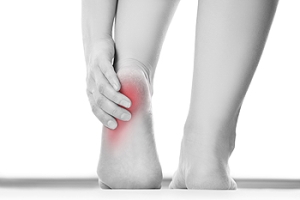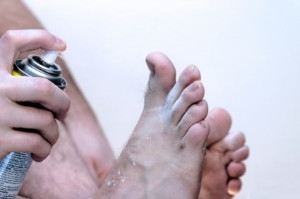Connect With Us
Blog

Edema and Pregnancy
 Women who are pregnant are aware of the changes that are occurring in their bodies. These may include pain in the feet while walking or standing. The reasons for this is due to the amount of weight gain that happens, and pressure is exerted near the arch of the foot and surrounding areas. The muscles of the feet may be strained as a result of change in gait, and this may happen to accommodate wider feet. This can lead to wearing shoes that are too tight, which may cause ingrown toenails to develop. Many pregnant women experience edema, which is known as swelling of the feet. Mild relief may be felt when the feet are resting, and elevated above heart level. Many women may find it beneficial to wear orthotics, and to incorporate a gentle foot exercise regime into their daily routine. If you are experiencing severe pain and discomfort in your feet as a result of pregnancy, it is suggested to speak to a podiatrist who can offer relief advice.
Women who are pregnant are aware of the changes that are occurring in their bodies. These may include pain in the feet while walking or standing. The reasons for this is due to the amount of weight gain that happens, and pressure is exerted near the arch of the foot and surrounding areas. The muscles of the feet may be strained as a result of change in gait, and this may happen to accommodate wider feet. This can lead to wearing shoes that are too tight, which may cause ingrown toenails to develop. Many pregnant women experience edema, which is known as swelling of the feet. Mild relief may be felt when the feet are resting, and elevated above heart level. Many women may find it beneficial to wear orthotics, and to incorporate a gentle foot exercise regime into their daily routine. If you are experiencing severe pain and discomfort in your feet as a result of pregnancy, it is suggested to speak to a podiatrist who can offer relief advice.
Pregnant women with swollen feet can be treated with a variety of different methods that are readily available. For more information about other cures for swollen feet during pregnancy, consult with one of our podiatrists from Family Foot Care of Long Island. Our doctors will attend to all of your foot and ankle needs.
What Foot Problems Can Arise During Pregnancy?
One problem that can occur is overpronation, which occurs when the arch of the foot flattens and tends to roll inward. This can cause pain and discomfort in your heels while you’re walking or even just standing up, trying to support your baby.
Another problem is edema, or swelling in the extremities. This often affects the feet during pregnancy but tends to occur in the later stages.
How Can I Keep My Feet Healthy During Pregnancy?
- Wearing orthotics can provide extra support for the feet and help distribute weight evenly
- Minimize the amount of time spent walking barefoot
- Wear shoes with good arch support
- Wear shoes that allow for good circulation to the feet
- Elevate feet if you experience swelling
- Massage your feet
- Get regular, light exercise, such as walking, to promote blood circulation to the feet
If you have any questions please feel free to contact our office located in Port Jefferson Station, NY . We offer the newest diagnostic and treatment technologies for all your foot and ankle needs.
Foot Care for Pregnant Women
The natural weight that pregnant women gain causes their center of gravity to be completely altered. This causes them to have a new weight-bearing stance which adds pressure to the knees and feet. As a result, pregnant women often experience severe foot pain. The two most common foot issues experienced by women in their pregnancies are edema and over-pronation. It is important for all pregnant women to learn more about how to take care of their feet so they are more comfortable during their pregnancy.
Over-pronation, which is commonly referred to as flat feet, is caused when a person’s arch flattens out upon weight bearing. This causes the person’s feet to roll inward while walking. Pregnant women often experience this due to the sudden weight they gain.
Edema, also referred as swelling in the feet, typically occurs in the later part of the pregnancy. It is the result of the extra blood accumulated in the pregnant woman’s body. The enlarged uterus puts more pressure on the blood vessels in the pelvis which causes leg circulation to slow down. This causes blood to pool in the lower extremities.
Fortunately, there are ways to treat both edema and over-pronation. Edema can be treated by elevating the foot as often as possible. Wearing proper fitting footwear will also be helpful for those with edema. A treatment method for over-pronation could be orthotics. Orthotic inserts should be designed with appropriate arch support and medial rear foot for your foot.
It is best for pregnant women to buy new shoes during the day, because this is the time where swelling is at its peak. Pregnant women also shouldn’t rush when buying shoes. It is always advised that you make sure your shoes fit properly but this is especially important during pregnancy.
If you are a pregnant woman, you should consult with a podiatrist in order to make sure your feet are healthy throughout the entirety of your pregnancy.
Possible Reasons Why Plantar Fasciitis May Develop
 The function of the plantar fascia is to connect the heel to the calf muscles. If you are experiencing pain on the bottom of your foot, you may have a condition that is referred to as plantar fasciitis. The plantar fascia is the largest ligament in the body, and if this should become irritated and inflamed, the result may be plantar fasciitis. There are specific symptoms that are typically associated with this condition. These may include tenderness, stiffness, or pain and discomfort in the heel and surrounding areas. Common reasons why this ailment may occur may come from excessive strain the ligament may endure. This may happen as a result of frequent walking or running, or from wearing shoes that do not fit correctly. When stretching exercises are performed daily, the pain may be minimized. If you are afflicted with plantar fasciitis, it is suggested that you consult with a podiatrist who can properly diagnose this condition, and begin correct treatment techniques.
The function of the plantar fascia is to connect the heel to the calf muscles. If you are experiencing pain on the bottom of your foot, you may have a condition that is referred to as plantar fasciitis. The plantar fascia is the largest ligament in the body, and if this should become irritated and inflamed, the result may be plantar fasciitis. There are specific symptoms that are typically associated with this condition. These may include tenderness, stiffness, or pain and discomfort in the heel and surrounding areas. Common reasons why this ailment may occur may come from excessive strain the ligament may endure. This may happen as a result of frequent walking or running, or from wearing shoes that do not fit correctly. When stretching exercises are performed daily, the pain may be minimized. If you are afflicted with plantar fasciitis, it is suggested that you consult with a podiatrist who can properly diagnose this condition, and begin correct treatment techniques.
Plantar fasciitis can be very painful and inconvenient. If you are experiencing heel pain or symptoms of plantar fasciitis, contact one of our podiatrists from Family Foot Care of Long Island. Our doctors can provide the care you need to keep you pain-free and on your feet.
What Is Plantar Fasciitis?
Plantar fasciitis is the inflammation of the thick band of tissue that runs along the bottom of your foot, known as the plantar fascia, and causes mild to severe heel pain.
What Causes Plantar Fasciitis?
- Excessive running
- Non-supportive shoes
- Overpronation
- Repeated stretching and tearing of the plantar fascia
How Can It Be Treated?
- Conservative measures – anti-inflammatories, ice packs, stretching exercises, physical therapy, orthotic devices
- Shockwave therapy – sound waves are sent to the affected area to facilitate healing and are usually used for chronic cases of plantar fasciitis
- Surgery – usually only used as a last resort when all else fails. The plantar fascia can be surgically detached from the heel
While very treatable, plantar fasciitis is definitely not something that should be ignored. Especially in severe cases, speaking to your doctor right away is highly recommended to avoid complications and severe heel pain. Your podiatrist can work with you to provide the appropriate treatment options tailored to your condition.
If you have any questions please feel free to contact our office located in Port Jefferson Station, NY . We offer the newest diagnostic and treatment technologies for all your foot and ankle needs.
Plantar Fasciitis
The plantar fascia is a connective tissue in the heel that stretches across the bottom length of your foot. Plantar fasciitis occurs when the connective tissue becomes inflamed, causing heel pain and discomfort during physical activity. Although the condition is completely treatable, traditional methods can take up to a year to start becoming effective.
Plantar fasciitis is caused by a number of everyday activities, so understanding the condition is important for managing and treating it. One of the most common causes of plantar fasciitis is excessive running, especially with improper fitting or non-supportive shoes. Too much exercise can lead to the plantar fascia being overworked and overstretched, which can cause tears in the tissue. Along with improper fitting shoes, pronation, the rolling of the feet inward, is a common cause of plantar fasciitis. If not treated properly, the plantar fascia becomes overstretched and starts to tear, causing inflammation.
Despite the common causes of plantar fasciitis, there are many different treatment options. For less severe cases, conservative home remedies include taking anti-inflammatory drugs to alleviate pain, applying ice packs to the bottom of your foot and heel, slowly stretching and exercising your feet to re-strengthen the tissue, and using orthotic devices are all ways to help manage your plantar fasciitis.
For more severe cases, shockwave therapy has become a common solution for plantar fasciitis. Shockwave therapy can effectively break up the tissue on the bottom of your foot which facilitates healing and regeneration. This fights the chronic pain caused by plantar fasciitis. Even if this doesn’t work, surgery is always a final option. Surgery on the tissue itself can be done to permanently correct the issue and stop the inflammation and pain in your heels.
No matter what the case may be, consulting your podiatrist is the first and best step to recovery. Even the slightest amount of heel pain could be the first stage of plantar fasciitis. Untreated symptoms can lead to the tearing and overstretching of tissue. Because the tearing of tissue can be compounded if it remains ignored, it can evolve into a severe case. The solution is early detection and early treatment. Talk to your podiatrist about the possibilities of plantar fasciitis if you’re experiencing heel pain.
Flat Feet and Edema May Be Side Effects of Pregnancy
 Research has indicated many patients may develop foot problems as a result of pregnancy. The feet endure the weight of the body, and many uncomfortable foot conditions can arise as the pregnancy weight increases. A pregnant woman may notice the absence of an arch in her feet, and the feet may appear to look flat. Additionally, the feet may roll inward, and this may cause pain and discomfort to the feet and lower extremities. Many women who are pregnant are aware of excess swelling in their feet, which is known as edema. Comfort may be found if the feet are elevated frequently during the day, in addition to drinking plenty of fresh water, and avoiding or limiting salt intake. If you would like additional information about how pregnancy can affect your feet, please consult with a podiatrist.
Research has indicated many patients may develop foot problems as a result of pregnancy. The feet endure the weight of the body, and many uncomfortable foot conditions can arise as the pregnancy weight increases. A pregnant woman may notice the absence of an arch in her feet, and the feet may appear to look flat. Additionally, the feet may roll inward, and this may cause pain and discomfort to the feet and lower extremities. Many women who are pregnant are aware of excess swelling in their feet, which is known as edema. Comfort may be found if the feet are elevated frequently during the day, in addition to drinking plenty of fresh water, and avoiding or limiting salt intake. If you would like additional information about how pregnancy can affect your feet, please consult with a podiatrist.
Pregnant women with swollen feet can be treated with a variety of different methods that are readily available. For more information about other cures for swollen feet during pregnancy, consult with one of our podiatrists from Family Foot Care of Long Island. Our doctors will attend to all of your foot and ankle needs.
What Foot Problems Can Arise During Pregnancy?
One problem that can occur is overpronation, which occurs when the arch of the foot flattens and tends to roll inward. This can cause pain and discomfort in your heels while you’re walking or even just standing up, trying to support your baby.
Another problem is edema, or swelling in the extremities. This often affects the feet during pregnancy but tends to occur in the later stages.
How Can I Keep My Feet Healthy During Pregnancy?
- Wearing orthotics can provide extra support for the feet and help distribute weight evenly
- Minimize the amount of time spent walking barefoot
- Wear shoes with good arch support
- Wear shoes that allow for good circulation to the feet
- Elevate feet if you experience swelling
- Massage your feet
- Get regular, light exercise, such as walking, to promote blood circulation to the feet
If you have any questions please feel free to contact our office located in Port Jefferson Station, NY . We offer the newest diagnostic and treatment technologies for all your foot and ankle needs.
Pregnancy and Foot Health
Many pregnant women complain about foot pain while they are expecting. Foot pain can primarily be caused by weight gain and hormonal changes taking place in the body. By understanding how pregnancy impacts the health of a woman's feet, a pregnant woman can take action to keep her feet as healthy and comfortable as possible.
Because a woman's weight changes during pregnancy, more pressure is brought to bear on both the legs and the feet. This weight shift can cause two major foot problems: over-pronation, also known as flat feet, as well as edema, which is swelling of the feet. Over-pronation occurs when the arch of the foot flattens, causing the foot to roll inwards when the individual is walking, and can aggravate the plantar fascia tissues located along the bottom of the feet. If these tissues become inflamed, a pregnant woman can experience pain in the heel of the foot as well as severe foot pain while walking or standing. Swelling of the feet, or edema, often occurs in the later stages of pregnancy. It is caused by slow circulation and water retention, and may turn the feet a light purple color.
To keep feet in good health and prevent over-pronation, pregnant women should avoid walking barefoot and be sure they are wearing shoes that offer good arch support. A device known as an orthotic can be added to regular footwear in order to provide additional support for the feet during pregnancy. Any expectant mother whose feet hurt should first check to see if the shoes she is wearing are old, worn out and not offering the proper support necessary for distributing the weight of her body during pregnancy.
To treat edema of the feet, a good start is to wear quality footwear which offers support and good circulation. Keep feet elevated whenever possible by using a foot stool while seated. Stay well hydrated by drinking plenty of water to prevent water retention in the feet. Any swelling that occurs in only one foot should be examined as soon as possible by a doctor.
Good foot health during pregnancy can help expectant mothers avoid foot pain that leads to other health problems. Massaging the feet and doing regular gentle exercise like walking aids foot health by contributing to good circulation. Supportive shoes are also a good investment that will support foot health during pregnancy.
Stress Fractures May Be Common Among Athletes
 Stress fractures may be prevalent among athletes, if their chosen sport involves frequent running and jumping activities. These types of fractures may gradually develop from performing repetitive motions. Some of the symptoms that may be associated with stress fractures may include extreme tenderness, bruising, or noticeable swelling. There may be medical conditions that may cause this condition, including osteoporosis, or it may come from wearing shoes that do not fit correctly. After a proper diagnosis is performed, which may include having an MRI or bone scan taken, correct treatment may begin. This may consist of resting and elevating the foot, and a compression bandage may be recommended to reduce swelling. If you are having symptoms of a stress fracture, it is suggested to consult with a podiatrist who can properly treat this condition.
Stress fractures may be prevalent among athletes, if their chosen sport involves frequent running and jumping activities. These types of fractures may gradually develop from performing repetitive motions. Some of the symptoms that may be associated with stress fractures may include extreme tenderness, bruising, or noticeable swelling. There may be medical conditions that may cause this condition, including osteoporosis, or it may come from wearing shoes that do not fit correctly. After a proper diagnosis is performed, which may include having an MRI or bone scan taken, correct treatment may begin. This may consist of resting and elevating the foot, and a compression bandage may be recommended to reduce swelling. If you are having symptoms of a stress fracture, it is suggested to consult with a podiatrist who can properly treat this condition.
Activities where too much pressure is put on the feet can cause stress fractures. To learn more, contact one of our podiatrists from Family Foot Care of Long Island. Our doctors can provide the care you need to keep your pain free and on your feet.
Dealing with Stress Fractures of the Foot and Ankle
Stress fractures occur in the foot and ankle when muscles in these areas weaken from too much or too little use. The feet and ankles then lose support when walking or running from the impact of the ground. Since there is no protection, the bones receive the full impact of each step. Stress on the feet can cause cracks to form in the bones, thus creating stress fractures.
What Are Stress Fractures?
Stress fractures occur frequently in individuals whose daily activities cause great impact on the feet and ankles. Stress factors are most common among:
- Runners
- People affected with Osteoporosis
- Tennis or basketball players
- Gymnasts
- High impact workouts
Symptoms
Pain from the fractures occur in the area of the fractures and can be constant or intermittent. It will often cause sharp or dull pain with swelling and tenderness. Engaging in any kind of activity which involves high impact will aggravate pain.
If you have any questions please feel free to contact our office located in Port Jefferson Station, NY . We offer the newest diagnostic and treatment technologies for all your foot and ankle needs.
Dealing with Stress Fractures of the Foot and Ankle
Stress fractures are small breaks in the bone that are caused by repetitive stress. They typically occur due to overuse, forcing the bones of the foot or ankle to continually absorb the full impact of each step taken. Stress fractures can also be caused by abnormal foot structure, osteoporosis, bone deformities, or wearing improper footwear during exercise.
Stress fractures are common for individuals whose daily activities cause high levels of impact on their feet and ankles. Those who run, play tennis or basketball, or practice gymnastics tend to experience these fractures more frequently. Anyone is susceptible to this problem, though. Individuals who are normally sedentary and suddenly begin an intense, high impact workout may sustain stress fractures. This is because their muscles are not yet strong enough to handle and cushion the intensity of their activity. Osteoporosis may also cause someone to get stress fractures, because the disease weakens an afflicted person's bones and makes it easier for them to break down.
Pain from stress fractures typically occurs in the general area of the fracture. Pain can also manifest as “pinpoint pain” or pain that is felt when the site of the injury is touched, and can be accompanied by swelling. It may occur during or after activity, and it may disappear while resting and return when standing or moving. Engaging in any kind of activity, high impact or otherwise, will aggravate the pain. If the intensity of the activity increases before the stress fracture has properly healed, it can cause a full fracture.
Treatment can vary depending on the individual and the degree of injury. The primary way to treat a stress fracture is to rest the hurt foot. Some fractures will heal quickly with only a little bit of rest, while others may require a long rest period and the use of crutches, immobilization, or physical therapy. Under certain circumstances, surgery may be required to install support pins around the fracture to assist in healing.
If you are undergoing a new exercise regimen in running or some other kind of high impact activity, set incremental goals on a weekly basis so you can build up muscle strength. Make sure to wear supportive shoes to better protect you feet.
If you begin to experience any symptoms of stress fractures, you should stop exercising and rest. If the symptoms persist, consult with your podiatrist. Remembering these tips can help you prevent stress fractures to your foot and ankle, and allow you to continue living normally.
What Are the Symptoms of Athlete’s Foot?
 If you notice an uncomfortable rash on your foot, you may have a condition that is known as athlete’s foot. Symptoms of this ailment include a burning sensation between the toes or on the soles of the feet, in addition to dry and flaky skin. In severe cases, blisters can form. It is known to be contagious, and it is important to take precautions, which can help to prevent this condition. These include wearing appropriate shoes while in public pools, shower room floors, and surrounding areas. Additionally, it is helpful to alternate shoes that are frequently worn, and ensuring clean tools are used while pedicures are performed. It is beneficial to wear cotton socks, which is advantageous in absorbing any moisture the feet produces. If you notice you have this condition, it is suggested that you speak to a podiatrist who can offer proper treatment options.
If you notice an uncomfortable rash on your foot, you may have a condition that is known as athlete’s foot. Symptoms of this ailment include a burning sensation between the toes or on the soles of the feet, in addition to dry and flaky skin. In severe cases, blisters can form. It is known to be contagious, and it is important to take precautions, which can help to prevent this condition. These include wearing appropriate shoes while in public pools, shower room floors, and surrounding areas. Additionally, it is helpful to alternate shoes that are frequently worn, and ensuring clean tools are used while pedicures are performed. It is beneficial to wear cotton socks, which is advantageous in absorbing any moisture the feet produces. If you notice you have this condition, it is suggested that you speak to a podiatrist who can offer proper treatment options.
Athlete’s foot is an inconvenient condition that can be easily reduced with the proper treatment. If you have any concerns about your feet and ankles, contact one of our podiatrists from Family Foot Care of Long Island. Our doctors will treat your foot and ankle needs.
Athlete’s Foot: The Sole Story
Athlete's foot, also known as tinea pedis, can be an extremely contagious foot infection. It is commonly contracted in public changing areas and bathrooms, dormitory style living quarters, around locker rooms and public swimming pools, or anywhere your feet often come into contact with other people.
Solutions to Combat Athlete’s Foot
- Hydrate your feet by using lotion
- Exfoliate
- Buff off nails
- Use of anti-fungal products
- Examine your feet and visit your doctor if any suspicious blisters or cuts develop
Athlete’s foot can cause many irritating symptoms such as dry and flaking skin, itching, and redness. Some more severe symptoms can include bleeding and cracked skin, intense itching and burning, and even pain when walking. In the worst cases, Athlete’s foot can cause blistering as well. Speak to your podiatrist for a better understanding of the different causes of Athlete’s foot, as well as help in determining which treatment options are best for you.
If you have any questions please feel free to contact our office located in Port Jefferson Station, NY . We offer the newest diagnostic and treatment technologies for all your foot and ankle needs.
Athlete’s Foot
Athlete’s foot, or tinea pedis, is a skin disease caused by a fungal infection. The infection typically occurs between the toes, and the feet are most subject to this disease because shoes best create the warm, dark, and moist environment in which fungus thrives. Other areas that create a similar environment, such as swimming pools, public showers, and locker rooms; can also promote fungi growth.
Symptoms of athlete’s foot include dry skin, itching, scaling, inflammation, and blistering. Sometimes, blisters can evolve into the cracks or breaks in the skin. The exposed tissue can then create pain, swelling, and discharge. The spread of infection can cause itching and burning as well.
While athlete’s foot commonly occurs between the toes, it may also spread to the toenails or soles of the feet. Other parts of the body, such as the groin or underarms, can also become infected if they are touched after the original area of infection is scratched. Aside from physical contact, athlete’s foot can also spread through the contamination of footwear, clothing or bedsheets.
Proper foot hygiene is essential in preventing athlete’s foot. You can prevent the fungus from spreading by frequently washing your feet using soap and water, thoroughly drying the feet between the toes, changing shoes and socks every day to reduce moisture, and ensuring that bathroom and shower floors are disinfected. Other tips include using shower shoes, avoiding walking barefoot in public environments, wearing light and airy shoes, and wearing socks that keep the feet dry.
While treatment for athlete’s foot can involve topical or oral antifungal drugs, mild cases of the infection can be treated by dusting foot powder in shoes and socks. Any treatment used can be supplemented by frequently bathing the feet and drying the toes. If proper foot hygiene and self-care do not ease your case of athlete’s foot, contact your podiatrist. He will determine if the underlying cause of your condition is truly a fungus. If that is the case, a comprehensive treatment plan may be suggested with the inclusion of prescription antifungal medications.
Blog Archives
- April 2025
- March 2025
- February 2025
- January 2025
- December 2024
- November 2024
- October 2024
- September 2024
- August 2024
- July 2024
- June 2024
- May 2024
- April 2024
- March 2024
- February 2024
- January 2024
- December 2023
- November 2023
- October 2023
- September 2023
- August 2023
- July 2023
- June 2023
- May 2023
- April 2023
- March 2023
- February 2023
- January 2023
- December 2022
- November 2022
- October 2022
- September 2022
- August 2022
- July 2022
- June 2022
- May 2022
- April 2022
- March 2022
- February 2022
- January 2022
- December 2021
- November 2021
- October 2021
- September 2021
- August 2021
- July 2021
- June 2021
- May 2021
- April 2021
- March 2021
- February 2021
- January 2021
- December 2020
- November 2020
- October 2020
- September 2020
- August 2020
- July 2020
- June 2020
- May 2020
- April 2020
- March 2020
- February 2020
- January 2020
- December 2019
- November 2019
- October 2019
- September 2019
- August 2019
- July 2019
- June 2019
- May 2019
- April 2019
- March 2019
- February 2019
- January 2019
- December 2018
- November 2018
- October 2018
- September 2018
- August 2018
- July 2018
- June 2018
- May 2018
- April 2018
- March 2018
- February 2018
- January 2018
- December 2017
- November 2017
- October 2017
- September 2017





